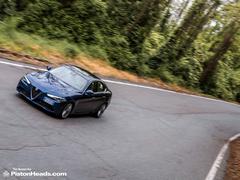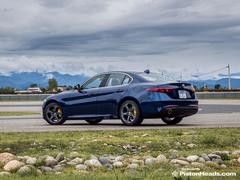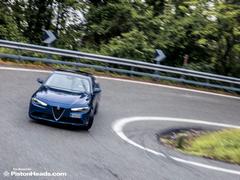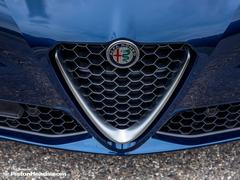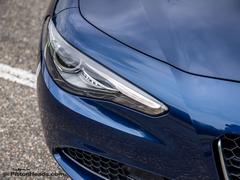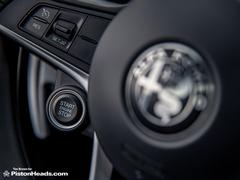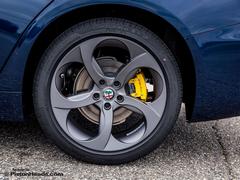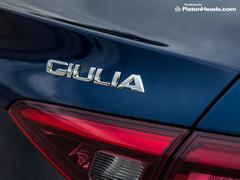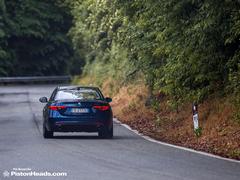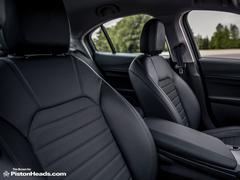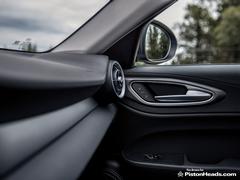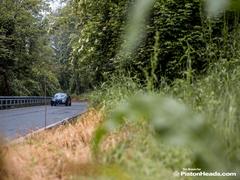2016 Alfa Romeo Giulia | Review
While the QV chases M3s and AMGs the rest of the range has to tempt us from our 320ds and C-Class diesels - is it up to it?
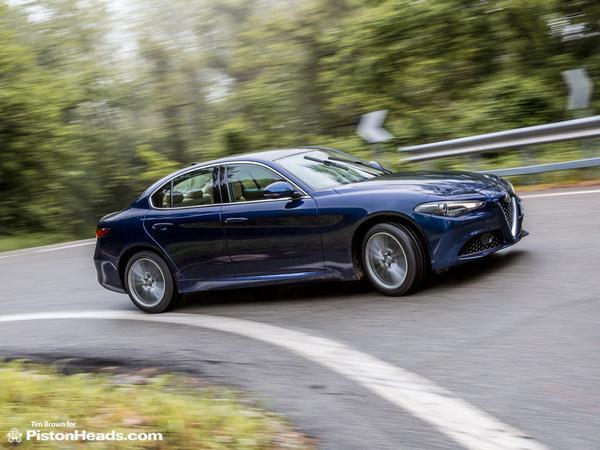
It was not, as you would imagine, perfect. The wheelarches were rusty, trim and suspension creaked over bumps and - as it always was - the 2.5-litre engine was a torque-free zone, pretty much refusing to get out of bed below 5,000rpm and reserving its snarliest noises for last couple of hundred revs before the 7,000rpm limiter.
But it also slapped some stark perspective on the scale of the challenge facing the new Giulia. The 156 was definitely Alfa's high water mark, selling strongly on the back of its handsome design and sparky dynamics. Even today it still feels charismatic and engaging.
By contrast the Giulia arrives with Alfa at one of its lowest ebbs, and is here to spearhead a product-led renaissance that, company boss Harald Wester assures us, will give us a full range of six cars by 2020. The aim of course being to help the company's beleaguered dealers to fill their showrooms with something other than Mitos, the 4C and tumbleweed.
If it had hands, the Giulia would hold the future of the company in them.
Trazione posteriore
As established in attention grabbing style by the Quadrifoglio Verde the basics are promising. The Giulia is rear-wheel drive, the first Alfa saloon to send its power to the back since the 75 died back in 1992. It sits on an all-new platform, one that will go onto underpin various other models including a small SUV. It's powered by a range of equally fresh engines, with new four-cylinder petrol and diesel turbos and aforementioned M3-rivalling QV with a 2.9-litre twin-turbo V6 and 510hp at the top of the range.
All right-hand drive versions will get an eight-speed automatic as standard; manuals are only being offered for left-hand drive. For similar reasons we won't get the all-wheel drive system that will be offered as an option on left-hookers; apparently demand isn't sufficient in any RHD territory to justify the costs of either the manual or integrale versions. Boo, hiss, etc.
Comparison with the 156 doesn't do many favours for the Giulia's styling. It's distinctive, but does without any of the design confidence of its grandfather. The mono nostril grille is pure Alfa - apparently I'm showing my age by still making Daniella Westbrook jokes - but the rest of it seems to have more influences than a teenage acid-funk-reggae band. I can't look at the side-on profile without thinking of the E46 BMW 3 Series - there's even a Hofmeister kink - and the back end seems to be riffing hard on the Infiniti Q50 and maybe even the Kia Magentis.
Style counsel
The cabin is spacious with usable room both front and rear and - getting sensible here - a decent sized boot. But the build quality of the cars at the launch event was, let's say, sub-optimal. Most seemed to manifest at least one electronics glitch and many of the interior mouldings feel flimsy, the switches on the centre console wobbling noticeably under pressure. The central display screen looks like it should be touch sensitive, but isn't. Instead it's controlled by an old-school turn-and-click wheel.
Sadly my plans to nab a Quadrifoglio and see what it will do on the Autostrada are stymied by the fact that it's been restricted to driving the track at Balocco, FCA's vast proving ground in northern Italy. Also through sheer pressure of numbers; Alfa has just four for 50-something journos. But then you knew about that already...
There's no shortage of diesel versions though, nor any restrictions about where to drive them. The engine is definitely class competitive, but not doing much to raise the segment average. The top-spec 180hp version spins up smoothly and stays quiet under everything but a caning, the standard eight-speed auto doing a decent job of keeping it in its powerband. Alfa claims a 7.1-second 0-62mph time - faster than the BMW 320d and Mercedes C220d - with the more relevant figure for most user-choosers probably the 109g/km CO2 figure.
Refined tastes
Refinement is good, indeed very good, with minimal road, wind and engine noise even at an indicated 160km/h on the Autostrada. It tracks straight at speed and ride quality felt good enough to have me deliberately aiming for potholes to try and catch it out; it's pliant and very well damped even on even the roughest tarmac. Alfa execs seem to prefer comparison to the 3 Series, but initial impressions are closer to the C-Class.
Corners enable the Giulia to show off some impressive agility. The steering is quick geared - bordering on too fast for my taste - with keen front end responses and lots of grip. Weighting is good and, although there's little feel through the EPS, the taut chassis gives a strong inertial sense of what's going on. Sending torque backwards definitely helps to minimise steering corruption, but it quickly transpires that it's not allowed to do anything else. There's less initial understeer than in a 3 Series, but approach the lateral limits of the rear tyres and the stability control steps in with all the subtlety and restraint of a Silvio Berlusconi pool party. It's not long before I'm looking for the off switch.
And not finding it, for the simple fact there isn't one. The rotary 'DNA' controller enables the usual selection between Normal, Dynamic and All-Weather modes, but it lacks the extra 'Race' position that the Quadrifoglio gets. Meaning no way to turn the traction even half-off, which seems a waste given how fundamentally decent the chassis seems to be in the Quadrifoglio. The result is a car that feels fast and accurate, but lacks much of a sense of fun. It's a bit clinical. And that's not really an Alfa word, is it?
Forza!
The petrol version scores a considerably nicer engine. There's a hint of lag as the twin-scroll turbo gathers pace, but it pulls harder and sounds far nicer while it does so. Peak power comes at 5,500rpm, and the automatic refuses to rev the engine past 5,750. Switching the manual mode and 'Dynamic' mode, which won't shift up when it reaches the limiter, proves the engine will go to 6,000rpm, but only for a couple of seconds before it winds itself back down to 5,750rpm. Which is a bit odd, but doesn't get in the way of the driveability. The stability control maintains its iron fist discipline, though. With the practical hat back on, CO2 emissions set to be under 140g/km aren't too bad either.
Yes, the lack of a manual gearbox is a bit disappointing. However, as 80 per cent of the segment in the UK now comes with a slusher and Alfa's making a standing start in a part of the market it's not been in for over five years, there's no surprise that investment has gone elsewhere. You don't install a new bathroom while your roof is on fire.
There's lots to like about the Giulia, there really is. Control weighting is pretty much spot-on, there's genuine feel through the brake pedal and the auto 'box shifts impressively quickly in its manual mode, and the metal change paddles behind the steering wheel feel great. It's got presence as well, certainly in Italy where the reaction to this home team champion seemed to be universally positive. In a segment where it seems to be almost impossible not to make a default choice, it's a breath of Alpine-crisp air - we just need to hope some of the niggles are addressed before it arrives later this year.
ALFA ROMEO GIULIA 2.2d 150/180
Engine: 2,143cc, four-cylinder turbo diesel
Transmission: 6-speed manual (8-speed auto), rear-wheel drive
Power (hp): 150@4,000rpm/180@3,750rpm
Torque (lb ft): 280@1,500rpm (332@1,750rpm)
0-62mph: 8.4sec (8.2sec)/7.2sec (7.1sec)
Top speed: 137mph/143mph
Weight: 1,374kg (1,445kg)
MPG: 67.3
CO2: 109g/km
Price: £35,000 (estimate)
Photos: Tim Brown
I'm sure the lower power petrols and diesels will be a breath of fresh air for fleet\company buyers as an alternative to the ubiquitous German rep diesels but there is nothing here to stir the blood of the enthusiast IMO which is a shame as a petrol manual with 300bhp or possibly even the QV was definitely on my radar as my next car.
Not even a DCT box? The 8 speed ZF is a decent auto but it doesn't belong in a performance saloon I'm afraid. The QV will be relegated for me to the same bin as AMG cars, good cars with great engines, spoiled by choice of gearbox.
The fact that they cite cost as the reason for not making a RHD manual petrol isn't promising though as I don't see that changing any time soon. A TCT is preferable to an auto but still not quite the real deal in terms of driver engagement IMO.
On that note aren't all cars electronic steering now? I don't see why manufacturers don't just go the whole hog, get rid of the steering rack and make it steer-by-wire. Surely this would free up quiet a bit of space which could be put to better use, decrease weight and avoid packaging problems such as this?
People don't trust things they don't understand. A lump of metal is something people can understand.

Aren't all modern planes fly-by-wire now? If it's good enough to keep several hundred tonnes of aircraft flying in the right direction, I'm sure it's good enough to keep a cars wheels pointing correctly too.

Gassing Station | General Gassing | Top of Page | What's New | My Stuff

